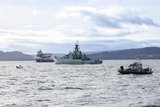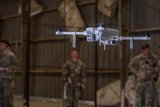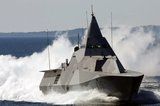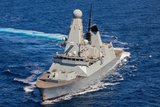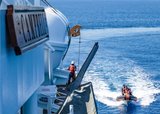US Navy takes delivery of New Jersey SSN
The USS New Jersey was christened in 2021. (Photo: HII)
USN has taken delivery of its 23rd Virginia-class nuclear fast-attack submarine USS New Jersey (SSN 796), the 11th boat built by HII Newport News Shipyard with 12 other boats built by General Dynamics Electric Boat.
USS New Jersey was christened in November 2021 at NNS and the submarine is expected to be commissioned later this year.
Under US Navy force-level goals announced in 2016, it has planned to have a total of 66 SSN, although this number will only be 46 by 2030. The US Navy’s current force of SSNs comprises 50 boats including 26 Los Angeles-class (SSN-68) boats, three Seawolf-class (SSN-21) boats and 23 Virginia-class boats.
As reported by Shephard, the succession of Virginia-class boats will eventually replace the Los Angeles-class with the intention to grow the SSN force to above 60 by FY2053, according to the US Navy’s FY2024 30-year shipbuilding plan announced in March 2023.
According to a Congressional Research Service (CRS) report on the Virginia-class SSN programme updated on 12 October 2023, the number of SSNs would dip from the mid-2020s to the early 2030s as a “consequence of having procured a relatively small number of SSNs during the 1990s, in early post-Cold War era.”
Shephard Defence Insight notes that Virginia-class boats have a submerged displacement of 7,925t and measures 114.8m in length, has a beam of 10.36m and a draft of 9.3m. The boats are powered by a GE PWR S9G nuclear reactor and two 40,000hp (29.84 MW) turbines, the submarines have an unlimited range and a maximum speed of at least 25kt.
Related Programmes in Defence Insight
Virginia Class Attack Submarine (SSN 812 - SSN 822)
Related Equipment in Defence Insight
More from Naval Warfare
-
![Sweden’s decision on four new warships inches closer as it eyes UK, France and Spain]()
Sweden’s decision on four new warships inches closer as it eyes UK, France and Spain
Sweden decided last year that it wanted a significantly larger warship for its Luleå Class programme than originally planned, with three likely contenders that could potentially deliver within the country’s tight schedule.
-
![How the use of artificial intelligence will affect the US Coast Guard’s acquisitions]()
How the use of artificial intelligence will affect the US Coast Guard’s acquisitions
The USCG is pursuing AI tools to improve the way the service conducts its procurement and fielding processes.
-
![US Coast Guard prepares procurement of next-gen surface search radar]()
US Coast Guard prepares procurement of next-gen surface search radar
The NXSSR will replace five in-service capabilities and be the US Coast Guard’s primary collision avoidance system.
-
![MBDA-led DragonFire’s latest trials move the LDEW system closer to UK Navy integration]()
MBDA-led DragonFire’s latest trials move the LDEW system closer to UK Navy integration
The DragonFire lines up with other European laser-directed energy weapons being developed in collaboration with MBDA.
-
![US Coast Guard pursues solutions to increase maritime domain dominance]()
US Coast Guard pursues solutions to increase maritime domain dominance
The USCG is seeking technologies, services and applications to better connect its assets and speed up the decision-making process.
-
![Canadian Coast Guard’s OOSV delivery is “major milestone” in fleet modernisation]()
Canadian Coast Guard’s OOSV delivery is “major milestone” in fleet modernisation
The Polar Class 6 platform is the largest CCG science-dedicated vessel and will operate on the country’s east coast.







